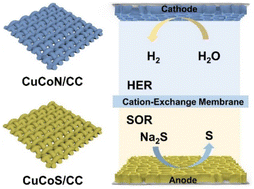Electrocatalytic sulfion recycling assisted energy-saving hydrogen production using CuCo-based nanosheet arrays†
Abstract
Establishing an efficient and cost-effective hydrogen production system is an important part of facilitating the energy mix transition. By replacing the kinetically slow oxygen evolution reaction (OER) with the thermodynamically advantageous sulfion oxidation reaction (SOR), a hybrid water electrolysis system combining the hydrogen evolution reaction (HER) and SOR is constructed to reduce the total energy consumption of hydrogen production, while achieving electrochemical conversion of high concentration Na2S solution to sulfur at the anode and producing high purity hydrogen at the cathode. However, due to the toxic and corrosive effects of sulfion, it is still a challenge to construct catalysts that can catalyze efficiently and stably in high-concentration Na2S solution. To this end, the precursor material CuCoO nanosheets on carbon cloth (CuCoO/CC) was nitrided and vulcanized to produce CuCoN/CC and CuCoS/CC for the HER and SOR, respectively. The hybrid water electrolysis system required only 0.75 V to achieve a current density of 100 mA cm−2 and to maintain the electrocatalytic stability for 144 h. In addition, the Faraday efficiency of both the cathode and anode is close to 100%. This research establishes an energy-saving hybrid water electrolysis system for hydrogen production and provides an effective solution for treating toxic waste.



 Please wait while we load your content...
Please wait while we load your content...